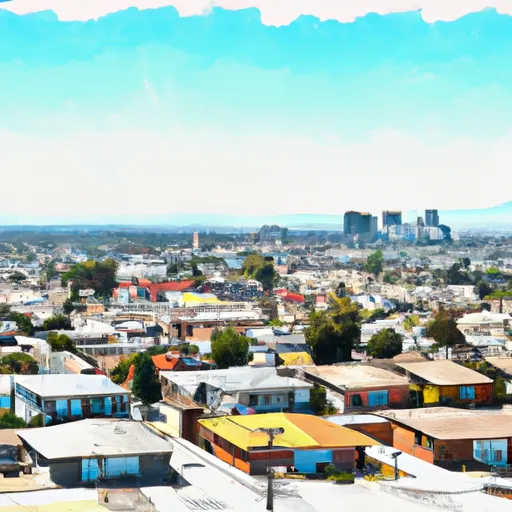-
 Snoflo Premium
Snoflo Premium
Get unlimited access to all our content
With no Ad interruptions! - Start Your Free Trial Login with existing account
South-Gate
Eden Index
Climate
9.2
•
Recreation
4.8
•
Community
1.7
•
Safeguard
5.8/10

South Gate, California is a vibrant city located in Los Angeles County. The climate in South Gate is typically Mediterranean, characterized by mild, wet winters and warm, dry summers. The average temperature ranges from 65°F (18°C) in winter to 85°F (29°C) in summer. The area receives about 14 inches of rainfall annually, primarily during the winter months.
South Gate is not directly situated on a major body of water, but it is in close proximity to the Los Angeles River, which has a significant impact on the hydrology of the region. The river plays a crucial role in providing water to the surrounding areas and supports various aquatic and avian species.
Outdoor enthusiasts in South Gate have access to a range of recreational opportunities. Nearby, the Rio Hondo Bike Path offers a scenic route for cycling and walking, stretching along the Rio Hondo River. Hollydale Regional Park is another popular destination, providing ample opportunities for picnicking, sports, and hiking. Additionally, within a short drive, residents can explore the diverse outdoor activities available in the greater Los Angeles area, such as hiking in the Santa Monica Mountains or visiting the beaches along the Pacific coast.
What is the Eden Index?
The Snoflo Eden Index serves as a comprehensive rating system for regions, evaluating their desirability through a holistic assessment of climate health, outdoor recreation opportunities, and natural disaster risk, acknowledging the profound impact of these factors on livability and well-being.
Climate Health Indicator (CHI): 9.2
South-Gate receives approximately
381mm of rain per year,
with humidity levels near 58%
and air temperatures averaging around
19°C.
South-Gate has a plant hardyness factor of
10, meaning
plants and agriculture in this region tend to thrive here all year round.
By considering the ideal temperature range, reliable water supplies, clean air, and stable seasonal rain or snowpacks, the Climate Health Indicator (CHI) underscores the significance of a healthy climate as the foundation for quality living.
A healthy climate is paramount for ensuring a high quality of life and livability in a region, fostering both physical well-being and environmental harmony. This can be characterized by ideal temperatures, reliable access to water supplies, clean air, and consistent seasonal rain or snowpacks.
Weather Forecast
Streamflow Conditions
Ventura-San Gabriel Coastal
Area Rivers
Ventura-San Gabriel Coastal
Snowpack Depths
Ventura-San Gabriel Coastal
Reservoir Storage Capacity
Ventura-San Gabriel Coastal
Groundwater Levels
Recreational Opportunity Index (ROI): 4.8
The Recreational Opportunity Index (ROI) recognizes the value of outdoor recreational options, such as parks, hiking trails, camping sites, and fishing spots, while acknowledging that climate plays a pivotal role in ensuring the comfort and consistency of these experiences.
Access to outdoor recreational opportunities, encompassing activities such as parks, hiking, camping, and fishing, is crucial for overall well-being, and the climate plays a pivotal role in enabling and enhancing these experiences, ensuring that individuals can engage in nature-based activities comfortably and consistently.
Camping Areas
| Campground | Campsites | Reservations | Toilets | Showers | Elevation |
|---|---|---|---|---|---|
| Devore | 6 | 2,914 ft | |||
| Sunset Vista RV Park | None | 19 ft | |||
| Bolsa Chica State Beach | 57 | 12 ft | |||
| Seabreeze at Seal Beach Military | None | 15 ft | |||
| Gould Mesa | 7 | 1,418 ft | |||
| Horse Flats | 25 | 5,639 ft | |||
| Oakwilde | 7 | 1,831 ft | |||
| Chilao | 111 | 5,333 ft | |||
| Los Alamitos Army Military | None | 25 ft | |||
| Millard | 5 | 1,980 ft |
Catastrophe Safeguard Index (CSI):
The Catastrophe Safeguard Index (CSI) recognizes that natural disaster risk, encompassing floods, fires, hurricanes, and tornadoes, can drastically affect safety and the overall appeal of an area.
The level of natural disaster risk in a region significantly affects safety and the overall livability, with climate change amplifying these risks by potentially increasing the frequency and intensity of events like floods, fires, hurricanes, and tornadoes, thereby posing substantial challenges to community resilience and well-being.
Community Resilience Indicator (CRI): 1.7
The Community Resilience Indicator (CRI) recognizes that education, healthcare, and socioeconomics are crucial to the well-being of a region. The CRI acknowledges the profound impact of these elements on residents' overall quality of life. By evaluating educational resources, healthcare accessibility, and economic inclusivity, the index captures the essential aspects that contribute to a thriving community, fostering resident satisfaction, equity, and social cohesion.

